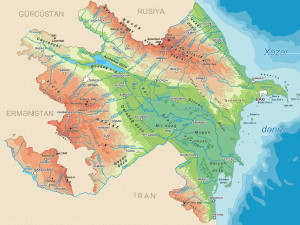Geography
The territory of the Republic of Azerbaijan forms a constituent geological part of the Alpine folded belt. Sedimentary deposits embracing the southwestern parts of the Major and Minor Caucasus, including the intermountain Kur-River trough, as well as the Mid- and South Caspian basins consist of diversity fold systems. The Earth’s crust thickness in Azerbaijan varies in the range from 38 to 55 km. Its maximum thickness is observed in the Minor Caucasus area, while its minimum thickness is typical for the Talysh foothills. Geological setting of the area consists of sedimentary, volcanic-sedimentary, volcanic and terrestrial deposits embracing almost entire stratigraphic range beginning from pre-Cambrian period up to Holocene time.
The Great Caucasus meganticlinorium, the Kur River intermontane trough and the Minor Caucasus megasynclinorium constitute the principle structural systems in Azerbaijan. The Major Caucasus meganticlinorium has very intricate structural architecture embracing ancient geologic features along with those generated recently. All constituent structures of the Major Caucasus meganticlinorium abruptly plunge towards the Caspian basin and terminate entirely within the coastal area.
Azerbaijan is situated on northern extremity of the subtropical zone, south-eastern Caucasus and north-western part of Iran plateau. Its climatic diversity is caused by the complicate geographical location and landscape, the proximity of the Caspian Sea, the effect of sun’s radiation, air masses of different origin, etc.
The Republic of Azerbaijan has a very rich flora. There are more than 4,500 species of higher plants here. The flora of Azerbaijan is much richer in the number of species than the flora of the other republics of the South Caucasus. Sixty-six per cent of the species growing in the whole Caucasus can be found in Azerbaijan. Relict genera of the tertiary period can be frequently found in all the zones of Azerbaijan, especially in Talysh. There are 240 endemic species of plants in Azerbaijan.
İn the Great and Minor Caucasus Mountains broad-leaved forests occur at 600-1,800 meters above sea level.
The diversity of various types of animals, which inhabit and populate a defined ground or water area, is the animal kingdom. The first reports on the richness and diversity of animal life in Azerbaijan can be found in travel notes of Eastern travelers. Animal carvings on architectural monuments, ancient rocks and stones survived up to the present times. The first information on the animal kingdom of Azerbaijan was collected during the visits of naturalists to Azerbaijan in 17th century. Unlike fauna, the concept of animal kingdom covers not only the types of animals, but also the number of individual species.
The animal kingdom of Azerbaijan is very rich, partly due to diversity of its natural complexes. There are 97 species of mammals, 357 species of birds, 67 species of reptiles and amphibians, 97 species of fish and over 15 thousand species of invertebrates in Azerbaijan.
The Red Book of the Azerbaijan Republic includes 108 species of animals, including 14 species of mammals, 36 species of birds, 13 species of reptiles and amphibians, 5 species of birds and 40 species of insects. The country’s fresh water basins and the Caspian Sea account for 30 species of fish. They are fished in the Kur River, surrounding lakes, as well as in the Mingechevir reservoir.




